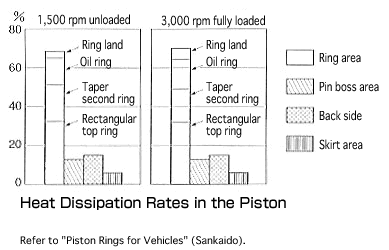The heat energy
in the piston is
absorbed by the
rings. The rings
then transfer
this heat into
the cylinder
walls and
eventually into
the engine
coolant or into
the surrounding
air (air-cooled
engine). The
table shown
below provides
data on this
heat dissipation
and transfer
phenomenon under
different engine
operating
conditions.

Since the piston
rings are in
firm contact
with both the
piston and
cylinder wall,
they can 'take'
heat energy from
the piston and
transfer this
heat into the
cylinder. The
graph above
shows that
approx. 70% of
the piston's
heat is carried
away by the
piston rings,
under both
unloaded and
loaded engine
operation
conditions, at
1,500 and 3,000
rpms
Above from Riken
Ring.. One of,
if not the,
largest ring
producer in the
world.
There are many
reasons why , I
THINK, BRP uses
a single ring on
the 800
1)When you have
less heat
transfer with a
single ring, the
ring gets
over-loaded and
ring seal fades
and with fading
you get
combustion
blow-by... With
blow-by you get
power LOSS.. So,
if you have
blow-by (which
you do) and you
Lose power
(which happens
with blow-by)
then you will
now be
over-fueling the
cylinder,
contaminating
the intake
charge (due the
blow-by) which,
in turn, lowers
charge purity,
which in turn,
lowers power...
So, now you have
made your engine
make less power
BUT you are
still feeding it
with the same
fuel (via carb
jets) for the
stock power..
So, now you have
created a
over-fueling
(rich) condition
inside the
engine.. Rich
conditions COOL
the piston which
is needed
because of the
ring over-load,
and this same
rich condition
also aids in the
power LOSS.. you
can not make
power with an
overly rich
condition...
So, it is a
cycle that
repeats over and
over.. ring
over-loads,
charge density
lessens, rich
conditions
occurs, power
ouput is
dimished, piston
cools, ring
seals normal
again, back to
stock power (or
close to it)
rinse, wash, and
repeat..
It is VERY hard
to seize an
engine with a
very rich
condition...
This is a very
good reason for
BRP to use a
single ring.
Less engine
failure due to
over-fueling.
2) DETONATION..
there is that
"buzz word"
again.. One of
the MAIN signs
of detonation is
hammering
between the
rings (2).. Deto
if left
untreated will
hammer out the
piston area
between the
upper and lower
rings.. This
area will crack
and eventually
break off
causing some
good engine
damage.. VERY
COMMON with
Detonation..
Well.. with 1
ring.. it is
impossible to
hammer out the
small area
between the 2
rings because
there is no
second ring...
ANOTHER good
reason for BRP
to use a single
ring..
3) HORSEPOWER (DYNO
POWER): single
ring pistons
WILL have less
drag then a
double ring
Epsecially when
the dual rings
are quite
thick.. and you
are comparing
them to a
thinner single
ring.. So, on
short pulls
(LIKE DYNO
PULLS) before
#1(above)
occurs, the dyno
run is over and
the output power
is up a few HP
due to the
shortness of the
dyno pull..
ANOTHER good
reason for BRP
to use a single
ring...>>>> MORE
DYNO POWER! =
Better
advertising and
better sales..
NOTE: as this
single ring gets
thicker and
thicker (like it
is) the
difference in
drag between 2
thin rings and 1
thick ring
become less and
less..
NOTE#2: Thicker
rings HATE
higher rpms..
You get what is
called ring
flutter with
high rpms and
thick rings..
Thinner rings
are a standard
cure for ring
flutter... Also
the Dykes (L
ring) used on
the 670 engine
was designed
just to combat
ring flutter..
However, the
Dykes rings has
other negatives
that accompany
it which is why
it was abandoned
for standard key
stone rings.
NOTE.. The RK
Tek Drop in Kit
for the Series
III Engine uses
2 very thin
rings... Just
some FYI..
Anyway.. the
above is only
some technical
info based on
KNOWN data on
how rings
function . it is
not speculation
on the part of
what happens
with single
rings, thick
rings, thin
rings, ring
flutter dual
rings.. etc.
etc.. It is
known facts that
can be backed up
with SAE papers
and just common
knowledge..
What IS
speculation , on
my part, is the
added verbage
about "WHY" BRP
uses a single
ring.. I have no
inside info on why
they do it.. I
just know what
happens
internally with
the engine and
piston and
SPECULATED and
Formed a THEORY
as to Why BRP
MAY have went
this route.